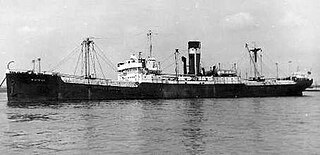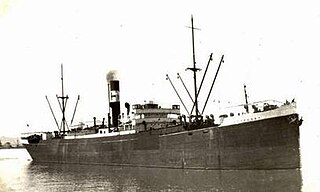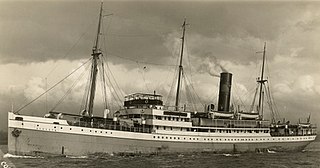
SS Ceramic was a steam ocean liner built in Belfast for White Star Line in 1912–13 and operated on the Liverpool – Australia route. Ceramic was the largest ship serving the route until P&O introduced RMS Mooltan in 1923.

SS Clan Macwhirter was a British cargo steamship. She was built in 1918 as Ypresville in the First World War and sunk by enemy action in 1942 in the Second World War. In her 24-year career she also carried the names Halizones and Willcasino.
SS Assyrian was a cargo ship that was built in Hamburg for German owners in 1914, transferred to British owners in 1920 as war reparations and sunk by a U-boat in 1940. She was launched as MS Fritz, and when she changed owners in 1920 she was renamed MS Assyrian. She had been built as a motor ship but in 1925 she was converted to a steamship and became SS Assyrian.

SS Blairspey was a steam cargo ship that was built in Scotland in 1929 and served in the Battle of the Atlantic in the Second World War. In 1940 she survived being part of Convoy SC 7 and managed to reach port, despite being hit by at least three torpedoes from two different U-boats. The ship was rebuilt with a new bow and renamed Empire Spey 1942. Her original name was restored in 1946. She was renamed Evandros 1961 and scrapped in Italy in 1967.
SS Beatus was a British cargo steamship that was built in 1925, sailed in a number of transatlantic convoys in 1940 and was sunk by a U-boat that October.

SS Somersby was a British cargo steamship that was built in 1930, sailed in a number of convoys in the Second World War and was sunk by a U-boat in 1941.

SS Soesterberg was a Dutch-owned cargo steamship that was built in Belgium in 1927 and sunk by a U-boat in 1940 in the Battle of the Atlantic.

SS Fiscus was a UK cargo steamship that was built in 1928, served in the Second World War and was sunk by a U-boat in 1940.

SS Scoresby was a British cargo steamship that was built in 1923, sailed in a number of transatlantic convoys in 1940, and was sunk by a U-boat that October.
SS Manistee was an Elders & Fyffes Ltd banana boat that was launched in 1920. She was one of a numerous class of similar banana boats built for Elders & Fyffes in the 1920s.
SS Tregenna was a cargo steamship that was launched in England in 1919 and sunk by a U-boat in the Battle of the Atlantic in 1940 with the loss of 33 of her 37 crew. She was laid down as War Bulldog, but the Hain Steam Ship Co bought her before she was completed and renamed her Tregenna.

SS Hilary was a British steam passenger liner that was built in 1931 and scrapped in 1959. She spent much of her career on a scheduled service between Liverpool in England and Manaus in Brazil.
SS Yoma was a British passenger liner that served as a troop ship in the Second World War. She was built in Scotland in 1928, and from then until 1940 Yoma ran a regular route between Glasgow in Scotland and Rangoon in Burma via Liverpool, Palma, Marseille and Egypt. She became a troop ship in 1941 and was sunk with great loss of life in the Mediterranean in 1943.

SS Anselm was a British turbine steamship of the Booth Steamship Company. She was built as a cargo and passenger liner in 1935 and requisitioned and converted into a troop ship in 1940. A German submarine sank her in 1941, killing 254 of those aboard.

SS Oropesa was a British steam turbine ocean liner of the Pacific Steam Navigation Company (PSNC). She was built on Merseyside in 1920 and operated between Liverpool and South America. In 1941 the German submarine U-96 sank her in the Western Approaches, killing 106 people aboard.
SS Umona was a British cargo liner. She was built at Sunderland on the River Wear in 1910, survived the First World War and was sunk by enemy action off Sierra Leone, West Africa in 1941.

SS Avoceta was a British steam passenger liner. She was built in Dundee in 1923 and was sunk by enemy action in the North Atlantic in 1941. She belonged to Yeoward Line, which carried passengers and fruit between Liverpool, Lisbon, Madeira and the Canary Islands.
SS Tregarthen was a cargo steamship that was built in Scotland for the Hain Steam Ship Co in 1936. She was sunk with all hands by a U-boat in 1941 in the Battle of the Atlantic.
SS Hartlebury was a cargo steamship that was launched in Scotland in 1934 for J&C Harrison Ltd. A U-boat sank her in the Barents Sea in 1942 when Hartlebury was a member of the Arctic convoy Convoy PQ 17.
SS Pennington Court was a British cargo steamship. She was launched in 1924 as Rochdale and renamed Pennington Court in 1927. In the Second World War she carried iron ore, grain and other supplies to Britain. She was sunk with all hands in the Battle of the Atlantic in 1942.










